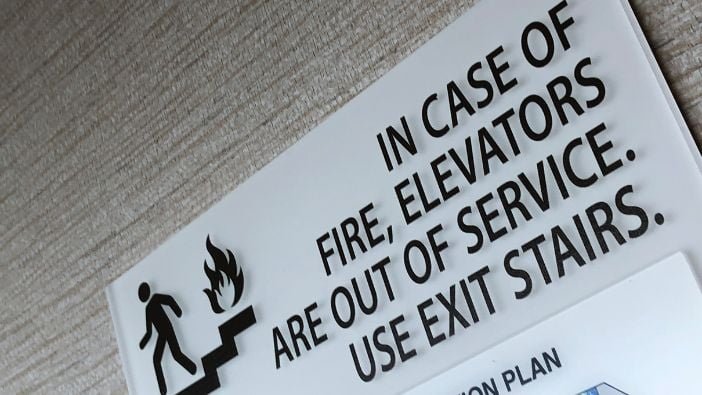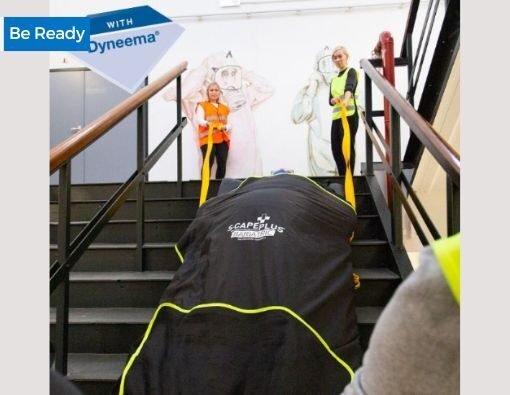Cinemas present unique challenges when it comes to emergency evacuations. The combination of large crowds, dark environments, and complex layouts can complicate getting everyone to safety quickly and efficiently. Understanding these challenges is the first step in developing effective evacuation plans and procedures.
Here are some of the primary challenges associated with evacuating a cinema during an emergency:

1. Large Crowds
- High Occupancy: Cinemas can accommodate hundreds of people in a confined space, particularly during popular movie showings. Managing the evacuation of such a large number of people can be daunting.
- Panic and Congestion: In an emergency, panic can spread quickly, leading to congestion and bottlenecks at exits. These slows down the evacuation process and increase the risk of injuries.
2. Darkened Environment
- Low Visibility: Screening rooms are typically dark, making it difficult for patrons to see exits and navigate safely. Low visibility can lead to confusion and slower evacuation times.
- Disorientation: The sudden change from darkness to emergency lighting can disorient patrons, especially if unfamiliar with the cinema’s layout.
3. Complex Layouts
- Multiple Exits: Cinemas often have multiple exits, which confuses patrons in an emergency. Ensuring that all exits are clearly marked and easily accessible is crucial.
- Maze-like Corridors: The layout of cinemas, with their numerous screening rooms, corridors, and stairwells, can make it challenging for patrons to find the quickest and safest exit route.
4. Varied Mobility and Special Needs
- Mobility Impairments: Some patrons may have mobility impairments and require assistance to evacuate safely. These includes elderly individuals, people with disabilities, and those using mobility aids.
- Families with Children: Families with young children may need extra time and assistance during an evacuation.
5. Communication Challenges
- Noise and Distractions: The noise from movies, with the general buzz of a crowded cinema, make it hard to hear emergency announcements.
- Language Barriers: In cinemas that attract a diverse audience, language barriers can complicate communication and understanding of evacuation instructions.
6. Behavioral Factors
- Reluctance to Leave: Some patrons might initially be reluctant to evacuate due to disbelief that there is a real emergency or the desire to finish watching the movie.
- Confusion and Fear: Fear and confusion can lead to irrational behavior, making it harder to manage a calm and orderly evacuation.

Strategies to Overcome Evacuation Challenges
1. Comprehensive Planning
- Develop detailed evacuation plans for the cinema’s layout, capacity, and specific challenges.
- Coordinate with local emergency services to ensure plans align with broader community emergency response efforts.
2. Clear Signage and Lighting
- Install clear, illuminated exit signs and emergency lighting to guide patrons to safety.
- Ensure that exit routes are free of obstructions and marked.
3. Regular Drills and Training
- Conduct regular evacuation drills to familiarize staff and patrons with emergency procedures.
- Train staff thoroughly on their roles and responsibilities during an evacuation, including how to assist patrons with special needs.
4. Effective Communication Systems
- Use loudspeakers, visual alerts, and multilingual announcements to ensure patrons receive clear evacuation instructions.
- Implement mass notification systems that quickly alert all patrons and staff to an emergency.
5. Evacuation Aids
- Utilize evacuation aids such as TETCON evacuation mats to assist patrons with mobility impairments.
- Place these aids in easily accessible locations and ensure staff are trained.
6. Behavior Management
- Train staff to manage crowds effectively and maintain calm during an evacuation.
- Provide clear, concise instructions to patrons to minimize confusion and panic.
7. Regular Maintenance and Inspections
- Regularly inspect and maintain all emergency equipment, including alarms, lighting, and evacuation aids.
- Ensure that all exits are operational and free from obstructions at all times.
Conclusion
Evacuating a cinema during an emergency presents numerous challenges, from managing large crowds and low visibility to navigating complex layouts and assisting patrons with varied mobility needs.
By understanding these challenges and implementing comprehensive emergency preparedness strategies, cinemas can enhance their ability to conduct safe and efficient evacuations.
Investing in training, effective communication systems, and appropriate evacuation aids like TETCON evacuation mats and sheets is essential for ensuring the safety and well-being of all patrons and staff.




